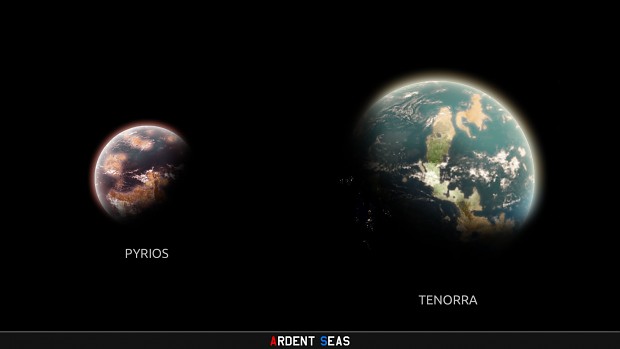Ardent Seas blends modern naval combat with classical RTS gameplay, featuring Aliens, space lasers, and unholy amounts of missiles
Pyrios and Tenorra
(view original)
Post a comment
Description
These are the worlds Ardent Seas takes place on. Pyrios is a planet about twice the size of Mars, orbiting a high-mass red dwarf which in turn orbits the same star as Tenorra, while Tenorra itself is somewhat larger than Earth. The main star of the solar system is a K2V class star, called Kepler.






That sounds like it's going to be one hell of a Hohmann transfer.
Probably makes one wish they could drop tungsten instead.
No Hohmanns in this case, they go full brachistochrone, at 3 gees for 3 months. One of the technologies that survived intact enough to reverse engineer were afterburning fusion engines, which can push a thousand-ton ship across the gap between the two planets in that timeframe. Of course, they first had to find that drive, since it was floating around in Kepler's asteroid belt.
Suddenly, I'm having evil, horrible, Kirklin mine-shaped ideas regarding that.
Then again, off the top off my head, that sounds like an energy output in the four-digit-Megawatt* range and five digit exhaust velocities, so lest I came in from the side, somehow, my idea would probably get vaporised by the thing accelerating before the 'target' would even notice there being something in the way.
Friggen Kzinti Lesson. :/
*Most likely entirely under the mark as far as the number goes, in which case just add zeroes till it works out.
The exhaust velocity is kind of crap for a fusion drive, but the mass-flow is quite a bit higher. As a result, the ships don't have the greatest payload fraction, being mostly deuterium and helium 3, with some titanium to contain it.
It's still going to be a pretty large number relative to chemical engines, and, coming back to my original point, with the mass flow to push your four-digit tonne ship at 3g, the area immediately prograde of it will still be a very uncomfortable mix of high-velocity fusion products, vaporised water or hydrogen from the afterburner*, and a few stray radioactive particles.
...so it would probably seriously affect an object that's trying to violently block its path.
*Bit of a misnomer with a rocket, though, isn't it? Works in the exact opposite of a conventional afterburner.
I got the term 'Afterburning Fusion Rocket' from Atomic Rockets.
And yeah, those engines don't treat anything behind them kindly when they fire. The TDN aren't all too worried about using insanely overpowered drive systems, though. Their newer space shuttles use solid core antimatter rockets.
As you should, lest your rockets be more powerful weapons than your actual weapons but I was mainly musing over the name at that point.
Still leaves me wondering how big a piece of tungsten you'd need to screw with someone's orbital insertion burn.
Not a very big one. A 105mm APDS round, fired from a railgun, would probably break a ship with engines that powerful running.
I did a brainfart and forgot the max temperature is limited by the reactor material anyway, so it doesn't really matter that much. >_>
So you -could- also take the same rough mass of tungsten, strap a solar panel and a chemical propulsion* bus to it, and tell it to stick its merry face in the way of any 'hot' interplanetary object without the proper clearance.
Yup, but if you expect to get more than one guy heading your way, a railgun is probably more efficient. Or fricken space laz0rs.
Probably depends on your orbital resourcing infrastructure.
A semi-autonomous mine that can actually sit out there without its fuel tank exploding will probably hit 100+kg dry mass pretty quickly, while your usual 105mm kinetic penetrator, at least groundside, is somewhere in the 5-10kg range (5 is -old-, and 10 seems to be DU), both ought to be pretty easy to mass produce if you don't have to drag their materials from the bottom of a gravity well, and the difference in velocity they'd achieve in impact is probably negated by their respective size differences, and the fact that the bulk of the impact when their use overlaps is going to be thoughtuflly provided by the target anyhow.
Though, yes, you'll be wanting to have guns* for a dedicated invasion. Or, perhaps both, since the purpose of one would be more to make entering orbit difficult, rather than impossible.
*And speaking of, something that I haven't seen mentioned in the context of space combat: How about a return to APCR rather than saboted shot? It's not like you have aerodynamics to contend with, and you already expended energy pushing that extraneous light(er) metal brick to muzzle velocity anyhow.
The TDN haven't really developed any space-railguns, instead, they've bolted a naval gun to a satellite, for the Falling Star array, which are usually meant to fire at surface targets, but can be pointed at anything. The sabots are built so that they will fall off from aerodynamic forces, but will stay attached in space. They use 203mm rails, though, the 105mm was just an example.
There are also 4 Guardian Star laser platforms on the L2, 3, 4 and 5 points of the Tenorra-Ares system, Ares being the largest of 4 moons, and the only one worth mentioning. The Guardian Star platforms are built to deflect asteroids, since Tenorra crosses an asteroid belt, and to kill ballistic missiles.
I'm going to write a much more in-depth description of the Kepler star system when I get the chance.